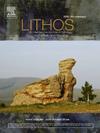Spatial and temporal characteristics of volatiles in the Cenozoic mantle beneath eastern China
IF 2.9
2区 地球科学
Q2 GEOCHEMISTRY & GEOPHYSICS
引用次数: 0
Abstract
Subduction of the paleo-Pacific Plate has transported volatiles from the surface to the interior of the Earth and significantly altered the chemical and physical properties of the Cenozoic mantle beneath eastern China. However, the characteristics of volatiles other than H2O in the Cenozoic mantle remain poorly constrained. To describe the spatiotemporal distribution of volatiles, including S, Cl, and H2O, in the Cenozoic mantle beneath eastern China, we performed reheating experiments and determined the composition of olivine-hosted melt inclusions from a large area (5.9 × 105 km2) of basalts. Calculations of the mantle-source compositions indicate that the Cenozoic mantle in North China is enriched in S but deficient in H2O and Cl, relative to that in South China. The distinctive features of volatiles likely arise from the different types of recycled materials in the mantle sources (such as Cl-containing sediments, carbonates, or sulfides in the altered oceanic crust) and their different proportions (from <1.7 % to 7 % of subducted sediments). Both the North China and South China mantles reached high volatile contents at 17.5–11.9 Ma, indicating that the activation of the South China mantle and the destruction of the North China Craton may have occurred simultaneously. These novel findings improve our understanding of mantle evolution beneath eastern China and will help in evaluating the contributions of slab subduction to the spatiotemporal heterogeneity of the lithospheric mantle during the Cenozoic.
中国东部地下新生代地幔中挥发物的时空特征
古太平洋板块的俯冲作用将地表的挥发物带到了地球内部,并极大地改变了中国东部地下新生代地幔的化学和物理特性。然而,对新生代地幔中除 H2O 以外的其他挥发物特征的研究仍然十分有限。为了描述中国东部新生代地幔中S、Cl和H2O等挥发物的时空分布,我们进行了再加热实验,并测定了大面积(5.9×105平方千米)玄武岩中橄榄石寄生熔融包裹体的成分。地幔源成分的计算表明,相对于华南地区,华北地区新生代地幔富含S,但缺乏H2O和Cl。挥发物的不同特征可能源于地幔源中不同类型的再循环物质(如含Cl的沉积物、碳酸盐或蚀变洋壳中的硫化物)及其不同比例(从占俯冲沉积物的1.7%到7%不等)。华北地幔和华南地幔在17.5-11.9 Ma时都达到了较高的挥发物含量,表明华南地幔的活化和华北克拉通的破坏可能是同时发生的。这些新发现加深了我们对中国东部地下地幔演化的理解,有助于评估板块俯冲对新生代岩石圈地幔时空异质性的贡献。
本文章由计算机程序翻译,如有差异,请以英文原文为准。
求助全文
约1分钟内获得全文
求助全文
来源期刊

Lithos
地学-地球化学与地球物理
CiteScore
6.80
自引率
11.40%
发文量
286
审稿时长
3.5 months
期刊介绍:
Lithos publishes original research papers on the petrology, geochemistry and petrogenesis of igneous and metamorphic rocks. Papers on mineralogy/mineral physics related to petrology and petrogenetic problems are also welcomed.
 求助内容:
求助内容: 应助结果提醒方式:
应助结果提醒方式:


